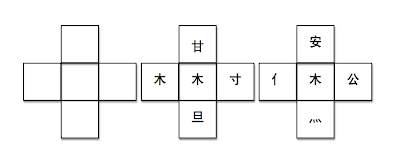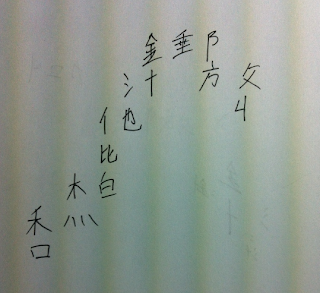![]() Got a few moments to spare between class, or during those weekly meetings? Love doing Sudoku, but wish there was something similar for practicing Chinese characters?
Got a few moments to spare between class, or during those weekly meetings? Love doing Sudoku, but wish there was something similar for practicing Chinese characters?
This week the Skritter blog is all about sharing fun ways to practice Chinese during life’s spare moments! We’ve found a few fun games that we would like to share, so grab a pen and paper and follow along.
1. Character boxes : Chinese characters are more than just a bunch of brush strokes on a page; they are like puzzle pieces made up of radicals and components that combined together to create Hanzi. A great way to practice the structural composition of characters is to make character boxes and see how many different ways you can mix and match the puzzle pieces. Not only is it a fun challenge, but it helps you keep the composition of Chinese characters fresh in your brain.
Here is how you do it.
- Draw five box grid, starting with one box in the center and then add four more on each side.
- Take a simple component or radical, like 木 or 白 etc. and place it in the center of the box.
- Fill in the surrounding boxes to create four different characters that all use the same middle component.
- Repeat the process until you can’t come up with any other characters. Even if you can’t fill in all the sides don’t just keep going with components in individual squares until you can’t think of any more.
 |
| With two just boxes I’ve created the following characters: 林,某,查,村,休,案,杰,松 |
2. Chinese character chains: Similar to character boxes, the chain game is all about connecting components to each other and seeing just how far you can string them along before the chain comes to an end. It doesn’t matter where you start, or with what component, but I would recommend that you pick common radicals at first until you get the hang of it. Once you’ve hit a dead end you can start with a different component and see how far you can get.
You can use multiple components or just one to make new characters, and the rules of the “game” are rather vague, but it is all about just putting the components that you know together to make as many words as you can. I tried this yesterday during some free time… can you see all the words I created? Get creative and see how far you can get.
 |
| I starting with 金 as a radical, and created the following characters: 針, 汁,池, 他, 偕 (two components) , 柏,杰,秋,和. After 和, I started back over at 金 making: 錘,郵,防,放,收. |
3. Character riddles: Chinese people love puns and riddles, they just go so well with the thousands of homophones that make Chinese such a fun and playful language. And they work just as well for Chinese characters. Here are a some fun ones I’ve found over the years. All the answers are just a single character, see how many you can get correct!
(answers will be posted in the comments below 24 hours after posting)
Component combinations (部件组合):
- 你是心上的人
- 一人一張口,口下長隻手 /一人一张口,口下长只手
- 從國外進口/从国外进口
- 老頭子/ 老头子
- 兩點水/ 两点水
- 日月同光
- 一心一意
- 只要出力就成功
- 一上一下,一小一大
- 爺頭
- 大公無私/ 大公无私
- (traditional only) 有雲無雨
- 草上飛/ 草上飞
- 池裡無水,地上無土/ 池里无水,地上无土
- 有意無心/ 有意无心
- 西站
- 西城
- 東洋/东洋
